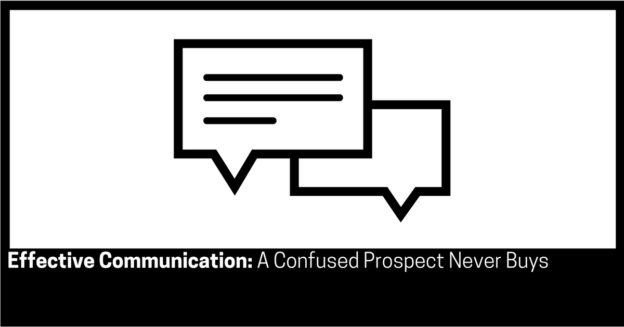There is an age-old sales saying that goes like this…
“A confused prospect never buys.”
This means it is critical to be an effective communicator if you want someone to buy.
And I’m not just talking about purchasing a product, service or solution with money.
I’m talking about every time you need to sell someone on something:
- Your idea;
- Your point of view;
- Your personal brand;
- Your suggestion;
- And so on…
Everyone is selling something, regardless if you like it or not (or acknowledge it or not!)
But, what is an effective communicator?
The term “effective” is as problematic and thin as words like “successful” and “happiness.”
Let’s start with some definitions…
Communication could be defined as conveying information to another through a medium, or modality—that is, a particular mode in which something exists, is experienced, or expressed.
Effective could be defined as successfully producing a desired or intended result.
Therefore, an effective communicator could be defined as successfully conveying information to another through a medium or modality to successfully produce a desired or intended result—that is, conveying the original information as intended with 100% accuracy, 100% of the time.
So how do you effectively communicate?
Let’s look at how communications works…
Communication has:
- A Communicator; and
- A Receiver.
The Communicator wants to convey information to the Receiver as intended with 100% accuracy, 100% of the time—that is, with no miscommunication.
And…
The Receiver wants to receive information from the Communicator as intended with 100% accuracy, 100% of the time—that is, again with no miscommunication.
The way information is conveyed or received could be through a medium or mode, such as:
- Body language;
- Vocal tonality;
- Language;
- Speech;
- Audio;
- Video;
- Writing;
- Visuals;
- And so on…
But, the problem with these medium or modes is way they convey information. They are flawed.
In other words, they cannot duplicate information from a Communicator to a Receiver as intended with 100% accuracy, 100% of the time.
Why is this?
Partly because, the information from a Communicator to a Receiver is conceptual.
A photo of a car is not ACTAULLY a car.
A verbal description of a dog is not ACTAULLY a dog.
The other part is that information collected by a Receiver from a Communicator has its own barriers, such as:
- Emotional filters;
- Cognitive biases;
- Learning styles;
- Personality types;
- Meta programs;
- And so on…
There is no perfect way to get rid of miscommunication.
Let me repeat, as it is important!
THERE IS NO PERFECT WAY TO GET RID OF MISCOMMUNICATION.
The thing is, the only communication you have control over is how you communicate, not how information is received.
But the paradox is that you need to understand the mental models of how information is collected by a Receiver to communicate in a way that reduces miscommunication for a Receiver.
Luckily, there are some simple tools that help you work these out, fast.
HINT: It’s doing so in a way they prefer to communicate, not how you want to communicate.
So, you had better get really good at it if you want to sell someone something.
And mark my words…
You sell someone on something multiple times aper day, regardless if you like it or not (or acknowledge it or not.)
Are you being effective as a communicator?
What opportunities are you missing because of miscommunication?
I bet there are a ton!
And alas, I’ll be bound to miscommunicate this information as intended.
How fitting 🙂

